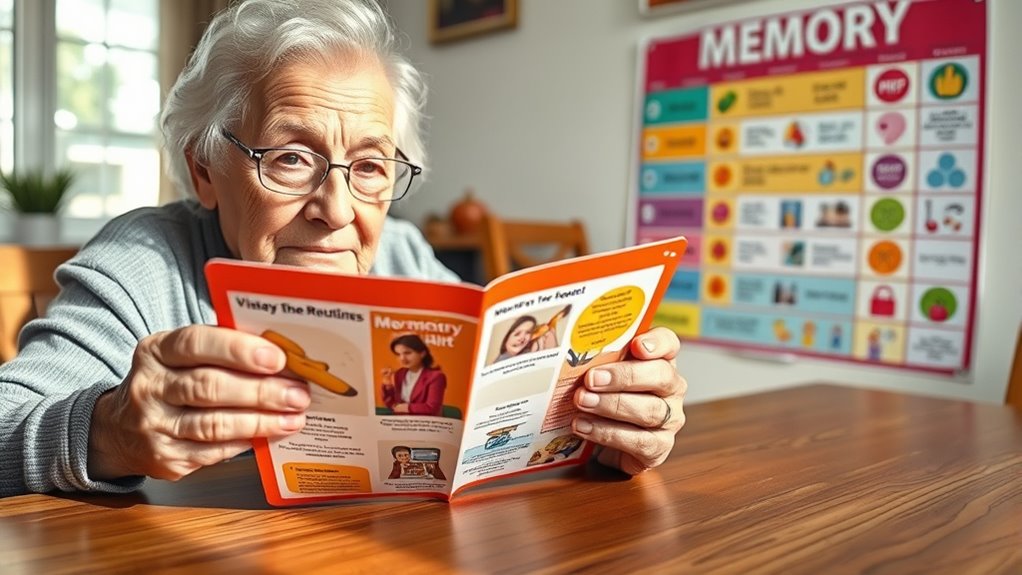To reduce repetitive questions in Alzheimer’s, create a calm, familiar environment with visual cues and consistent routines. Respond with patience and empathy, using gentle reassurance to build trust. Engage your loved one in simple activities they enjoy to help redirect their focus. Using memory aids and establishing predictable schedules can also lessen confusion. Keep exploring strategies, as applying these approaches can improve quality of interaction and comfort for both of you.
Key Takeaways
- Use gentle reassurance and empathetic communication to comfort the person and reduce anxiety causing repetitive questions.
- Implement visual cues, note boards, and labeled objects to support understanding and minimize confusion.
- Maintain consistent daily routines and a predictable environment to decrease uncertainty and repetitive questioning.
- Incorporate familiar objects, photos, and calming decor to foster recognition and emotional comfort.
- Practice patience, redirect attention, and engage in simple, meaningful activities to manage repetition calmly.
Understanding Why Repetitive Questions Occur

Repetitive questions are common in individuals with Alzheimer’s because their memory loss makes it difficult for them to recall recent conversations or information. When they forget what they’ve just learned or discussed, they may ask the same question repeatedly to seek reassurance or clarity. This behavior isn’t intentional; it’s a way for them to fill the gaps in their memory. Their brain struggles to connect new information with existing knowledge, leading to frustration and confusion. Repetition provides a sense of familiarity and comfort, even if they don’t remember asking before. Recognizing this as a result of cognitive decline helps you understand that the behavior isn’t meant to irritate you but stems from the disease’s effects on memory. Additionally, high contrast ratios in visual displays can help reduce confusion by making images clearer and easier to interpret. Using memory aids such as note boards or visual cues can also support their understanding and reduce questioning. Incorporating Automation technologies can also be utilized to provide consistent and patient responses to repetitive questions, easing caregiver burdens. Implementing cybersecurity measures in daily routines, such as secure digital communication, can also help protect sensitive information when caregivers seek support online.
Creating a Calm and Consistent Environment

Creating a calm and consistent environment helps reduce confusion and agitation. You can do this by sticking to daily routines and using soothing decor that promotes relaxation. These simple changes make your loved one’s surroundings more predictable and comforting. Embracing attention in practice by maintaining focus on familiar activities can further support a sense of stability. Incorporating environmental cues can also reinforce routines and ease navigation within the space. Utilizing regional flavors and traditions in the environment can also provide familiar sensory cues that promote comfort and recognition. Additionally, incorporating scenic views and natural beauty from outdoor environments can create a calming atmosphere that aids in reducing stress. Incorporating nutrient-rich ingredients in visual cues or sensory stimuli may also subtly enhance recognition and overall well-being.
Maintain Daily Routines
Maintaining daily routines helps establish a calm and predictable environment for individuals with Alzheimer’s. Consistent schedules reduce confusion and anxiety, making it easier for them to navigate daily activities. When you stick to regular meal times, sleep schedules, and activity periods, you create a sense of stability. This familiarity minimizes the likelihood of repetitive questioning and agitation.
To make routines effective, consider these tips:
- Keep daily activities simple and familiar
- Use visual cues to signal transitions
- Avoid sudden changes in schedule
- Reinforce routines with gentle reminders
Use Soothing Decor
Using soothing decor in the environment can substantially help reduce confusion and agitation in individuals with Alzheimer’s. A calm, consistent setting minimizes sensory overload and creates a sense of stability. Soft, neutral colors like blues and greens promote relaxation, while clutter-free spaces prevent overstimulation. Incorporate familiar objects and simple artwork to foster comfort and recognition.
| Calm Colors | Simple Furniture | Familiar Items |
|---|---|---|
| Blues, greens, whites | Comfortable chairs, low tables | Family photos, favorite toys |
| Gentle lighting | Clear pathways | Personal keepsakes |
| Minimal decorations | Consistent placement | Everyday essentials |
Using Memory Aids and Visual Cues

Using memory aids and visual cues can help your loved one stay oriented and reduce unnecessary questioning. Simple reminders like notes or labels serve as prompts, while visual aids in the environment provide clear guidance. These tools support independence and lessen frustration for both of you. Implementing designated zones can further enhance organization and help your loved one locate items easily. Incorporating familiar and consistent visuals can strengthen recognition and reduce confusion. Additionally, understanding ice cream flavors and their variations can be a comforting topic or activity that engages your loved one positively. Using pressure relief techniques and supportive tools like comfortable seating can also help manage agitation and provide calming effects. Integrating family photos into daily routines can also reinforce familiar environments and reduce anxiety.
Memory Cues for Reminders
Memory cues like visual aids and simple reminders can considerably reduce questioning in individuals with Alzheimer’s. When you use clear, familiar cues, it helps the person recall important information and feel more independent. For example, placing a calendar or daily schedule in a visible spot can remind them of appointments or routines. Using labeled objects or pictures next to doors can signal where items belong or indicate what they’re for. Consistent placement of belongings prevents confusion and reduces repeated questions. Incorporating these cues makes daily tasks smoother and reduces frustration for both of you.
- Use labeled objects to identify items
- Place visual schedules in prominent locations
- Keep belongings in consistent spots
- Use simple signs or pictures for instructions
Visual Aids and Environment
Visual aids and thoughtfully arranged environments play a crucial role in helping individuals with Alzheimer’s navigate daily life. You can use simple labels, signs, and visual cues to guide them through routines and reduce confusion. Clear labels on doors, cabinets, and appliances help answer questions before they’re asked. Visual cues like color-coded areas or pictures indicate specific locations or activities, providing reassurance and independence. Organizing the environment with consistency minimizes disorientation. Here’s a helpful example:
| Area | Visual Aid | Purpose |
|---|---|---|
| Kitchen | Picture of stove and fridge | Identify cooking and food storage |
| Bathroom | Toilet sign with picture | Find bathroom quickly |
| Bedroom | Photo of bed | Recognize sleeping area |
| Living Room | Calendar with pictures | Remind of daily schedule |
| Front Door | Sign with “Exit” | Prevent wandering |
Using these visual cues makes daily navigation easier and reduces repetitive questions.
Establishing Routines and Predictable Schedules

Establishing routines and predictable schedules can considerably reduce confusion and agitation for individuals with Alzheimer’s. When your loved one knows what to expect, they feel more secure and less likely to ask repetitive questions. Consistency helps them build familiarity with daily activities, reducing uncertainty. To create effective routines, keep a regular wake-up time, mealtimes, and bedtime. Use simple, consistent steps for daily tasks like dressing or bathing. Visual cues or written schedules can reinforce these routines.
Creating consistent routines helps reduce confusion and provides comfort for those with Alzheimer’s.
- Maintain consistent daily routines to foster familiarity
- Use visual aids like charts or pictures for key activities
- Keep progressions between activities smooth and predictable
- Reinforce routines with gentle reminders and cues
Responding With Patience and Empathy

Responding with patience and empathy is essential when communicating with someone with Alzheimer’s, as their feelings and perceptions can be easily affected by frustration or misunderstanding. You can help by listening carefully, maintaining a calm tone, and validating their emotions. A gentle response reassures them and reduces anxiety. Remember, their questions may stem from confusion, not stubbornness. Here’s a visual to guide you:
| Situation | How to Respond | Emotional Impact |
|---|---|---|
| Repetitive question about time | Calmly remind them of the current time. | Feels heard and reassured. |
| Asking about loved ones | Express understanding, share comforting words. | Builds trust and connection. |
| Seeking familiar routines | Reaffirm routines gently, avoid frustration. | Reduces agitation, increases comfort. |
| Expressing frustration | Listen patiently, validate feelings. | Eases their emotional distress. |
| Confusion about surroundings | Reassure and guide them kindly. | Creates a sense of safety. |
Additionally, understanding that emotional responses can be influenced by their perception of the environment helps foster a more compassionate approach. Recognizing that repetitive questioning often relates to memory challenges can encourage more empathetic responses. Being aware of behavioral cues can further enhance your ability to respond appropriately and with kindness. Developing empathy and patience in these interactions is vital for providing effective support and nurturing trust. Recognizing the importance of patience and understanding in these interactions can significantly improve the quality of care and connection.
Redirecting and Engaging in Alternative Activities

When someone with Alzheimer’s becomes fixated on a repetitive question or behavior, redirecting their attention to a different activity can help break the cycle and reduce frustration. Engaging them in a new task shifts focus and calms anxiety. Choose activities that match their interests and abilities to guarantee success and enjoyment. Incorporating positive vibrational energy through activities can further enhance their mood and cooperation. Here are some effective options:
Redirecting attention to engaging activities can ease repetitive behaviors and reduce frustration in Alzheimer’s care.
- Playing simple, familiar games like puzzles or card games
- Listening to favorite music or singing songs
- Looking through photographs or reminiscing with keepsakes
- Doing gentle, hands-on tasks like folding towels or gardening
Utilizing remote hackathons or virtual events can also introduce stimulating activities that keep their minds engaged in a safe, accessible environment. Using retail hours information to plan visits for activities can help ensure a smooth experience and reduce confusion. Engaging in meaningful activities can promote a sense of accomplishment and connection, helping to ease repetitive questioning while fostering positive interactions. Additionally, fostering social connections can provide emotional support and reduce feelings of isolation.
Seeking Support and Professional Resources

Seeking support and professional resources is essential for managing the challenges of Alzheimer’s. You don’t have to face this journey alone. Local support groups connect you with others who understand what you’re experiencing, offering emotional comfort and practical advice. Healthcare professionals, such as neurologists and geriatric specialists, can provide assessments, medication management, and tailored strategies to reduce repetitive questioning. Caregiver organizations often offer training, respite services, and counseling, helping you maintain your well-being. Don’t hesitate to seek out community resources like adult day programs or home care services that can ease your daily responsibilities. By accessing these resources, you gain valuable support, guidance, and tools to cope more effectively while maintaining quality of life for your loved one.
Frequently Asked Questions
How Can I Prevent Repetitive Questioning From Escalating?
When you notice repetitive questioning escalating, stay calm and patient. Gently redirect their attention to a different activity or topic to break the cycle. Use reassurance and simple, clear answers to reduce confusion. Establish a routine to provide stability, and avoid arguing or correcting. Providing comfort and consistency helps lower anxiety, which lessens the likelihood of questions becoming more frequent or intense. Your patience and understanding make a big difference.
Are There Specific Communication Strategies to Reduce Repetition?
To reduce repetition, use clear, simple communication by speaking slowly and calmly. Repeat key information consistently, and use visual cues or written notes to reinforce your message. When your loved one asks the same question, gently redirect their attention to another activity or topic. Maintain a calm tone, avoid showing frustration, and be patient. These strategies help your loved one feel secure and reduce their need to ask the same questions repeatedly.
What Are the Signs That Repetitive Questioning Indicates Increased Confusion?
When you notice someone asking the same questions repeatedly, it often signals increased confusion or anxiety. They may seem restless, have trouble recalling recent events, or appear overwhelmed. You might see them fixate on specific topics or struggle to process new information. These signs suggest their cognitive state is worsening, and they need reassurance, patience, and clear, simple communication to help them feel more secure and reduce their frustration.
How Do Medication or Medical Conditions Influence Repetitive Behaviors?
Medication and medical conditions can markedly influence repetitive behaviors. You might notice that certain drugs, especially those affecting the brain like sedatives or antipsychotics, can increase confusion or agitation, leading to more repetitive questioning. Medical issues such as infections, pain, or metabolic imbalances also worsen cognitive function, making it harder for you to process information. Managing these conditions carefully can help reduce the frequency of repetitive behaviors.
Can Dietary Changes Help Minimize Repetitive Questioning in Alzheimer’S Patients?
Changing your loved one’s diet might help reduce repetitive questioning, as proper nutrition supports brain health and stability. Incorporate omega-3 fatty acids, antioxidants, and balanced meals to promote cognitive function. While dietary changes alone won’t eliminate the behavior, they can improve overall well-being and reduce anxiety, which may lessen repetitive questions. Always consult a healthcare professional before making significant dietary adjustments to guarantee safety and effectiveness.
Conclusion
Did you know that nearly 70% of caregivers report repetitive questioning as one of their biggest challenges? By understanding why it happens and creating a calm environment, you can reduce this behavior. Using memory aids, routines, and patience makes a big difference. Remember, seeking support when needed is essential. With these strategies, you’ll foster a more peaceful atmosphere, helping both you and your loved one feel more comfortable and connected each day.









